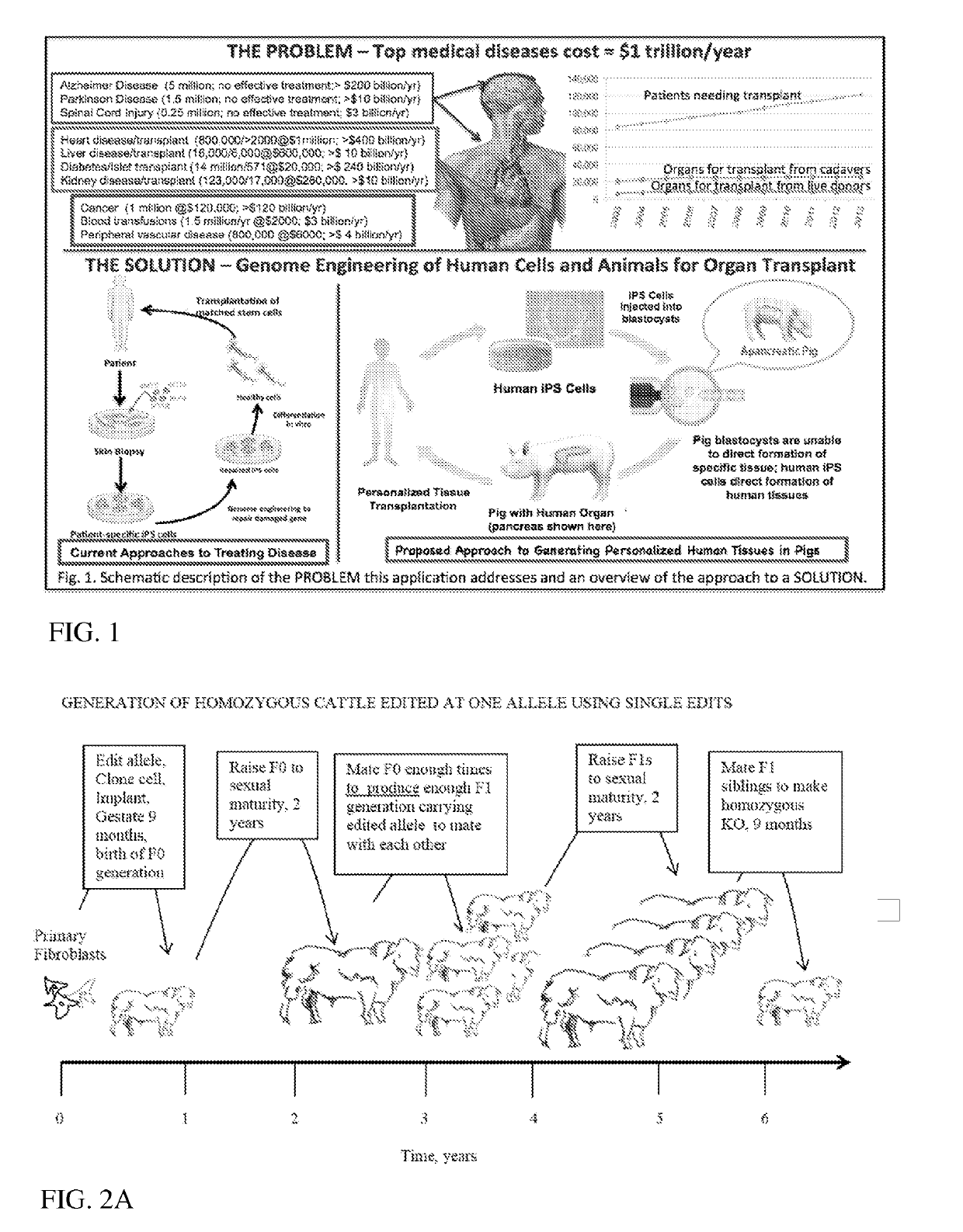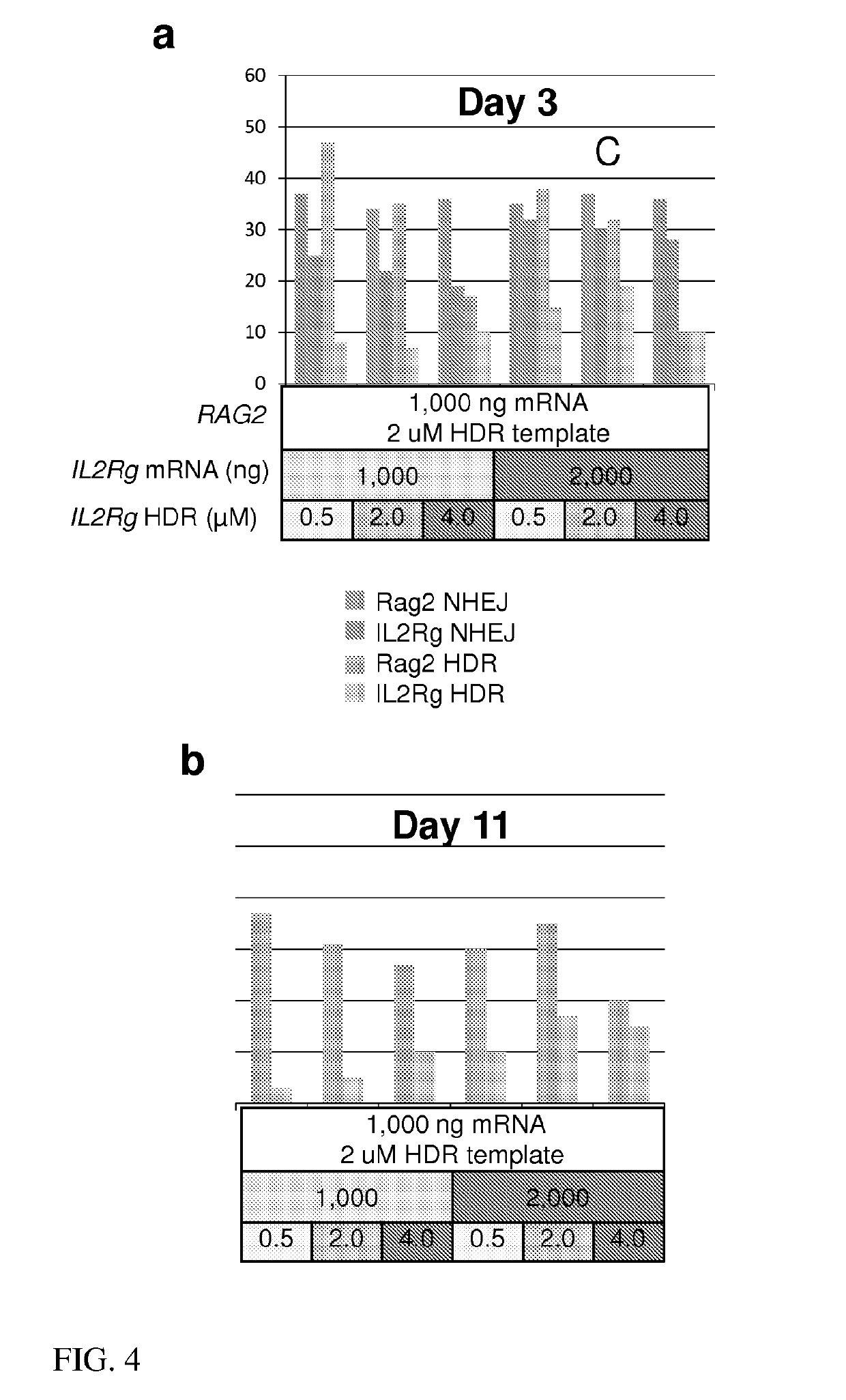Engineering of Humanized Kidney by Genetic Complementation
a technology of genetic complementation and kidney, applied in the direction of peptides, p53 proteins, peptide sources, etc., can solve problems such as eliciting other side effects
- Summary
- Abstract
- Description
- Claims
- Application Information
AI Technical Summary
Benefits of technology
Problems solved by technology
Method used
Image
Examples
example 1
Gene Editing of Pig RAG2 and IL2Rγ
[0224]Six conditions of TALEN mRNA and HDR templates directed to pig RAG2 and IL2Rγ were co-transfected into pig fibroblasts. A fixed quantity of RAG2 mRNA and template were used for each transfection whereas the quantity of IL2Rg TALEN mRNA and HDR template is altered for each condition as indicated. The dosage of TALEN mRNA and HDR template has both on and off target effects. An increase in TALEN mRNA for IL2Rγ led to an increase in both NHEJ and HDR for IL2Rγ while NHEJ levels for RAG2 were unchanged. An increase in IL2Rγ HDR template reduced HDR at the RAG2 locus suggesting a nonspecific inhibition of homology directed repair by escalation of the concentration of oligonucleotide. Colonies with bi-allelic HDR at RAG2 and IL2Rγ were obtained at four and two percent from two conditions (FIGS. 4C and 4D) which is at and above the expected frequency of two percent. The expected frequency is calculated by multiplication of day 3 HDR levels which treat...
example 2
Gene Editing of Pig RAG2 and IL2Rγ
[0225]Four conditions of TALEN mRNA and HDR templates directed to pig APC and p53 were co-transfected into pig fibroblasts. The quantity of APC mRNA was sequentially reduced from left to right (FIG. 5B); the remaining of the quantities remained constant as indicated. Percent HDR reduced in a linear manor with reduction of APC mRNA. There was little effect on p53 HDR with altered dosage of APC TALENs. Genotyping of colonies revealed a higher than expected union of clones with HDR allele in both APC and p53 relative to the day 11 values; 18 and 20 percent versus 13.7 and 7.1 percent for FIGS. 5C and 5D, respectively. Referring to FIGS. 5A-5D Multiplex gene editing of swine APC and p53. FIG. 5A Surveyor and RFLP analysis to determine the efficiency of non-homologous end joining (NHEJ) and homology depended repair HDR on cell populations 3 days post transfection. FIG. 5B RFLP analysis for homology dependent repair on cell populations 11 days post transf...
example 3
with at Least Three Genes
[0226]In Example 1, a non-specific reduction in HDR was observed at high concentration of HDR oligo, thus it was unknown whether 2+ HDR oligos could be effective without non-specific inhibition of HDR. Two concentrations were tested, 1 uM and 2 uM for each target site. While TALEN activity was not significantly altered between the two conditions, HDR was blunted significantly at 2 uM concentration for each template. Clones derived from the 1 uM condition had a variety of genotypes, some of those with edits in each gene and up to 7 alleles (FIGS. 7A and 7B). If treated as independent events, the expected frequency of the genotype denoted by an “a”, with 7 alleles edited, is 0.001 percent. Binomial distribution predicts the likelihood of identifying 2+ colonies of such a genotype in a sample size of 72, as was done here, is less than 0.000026 percent. This high rate of success could not be predicted and is unexpected and surprising. This result was replicated ...
PUM
| Property | Measurement | Unit |
|---|---|---|
| Fraction | aaaaa | aaaaa |
| Fraction | aaaaa | aaaaa |
Abstract
Description
Claims
Application Information
 Login to View More
Login to View More - R&D
- Intellectual Property
- Life Sciences
- Materials
- Tech Scout
- Unparalleled Data Quality
- Higher Quality Content
- 60% Fewer Hallucinations
Browse by: Latest US Patents, China's latest patents, Technical Efficacy Thesaurus, Application Domain, Technology Topic, Popular Technical Reports.
© 2025 PatSnap. All rights reserved.Legal|Privacy policy|Modern Slavery Act Transparency Statement|Sitemap|About US| Contact US: help@patsnap.com



